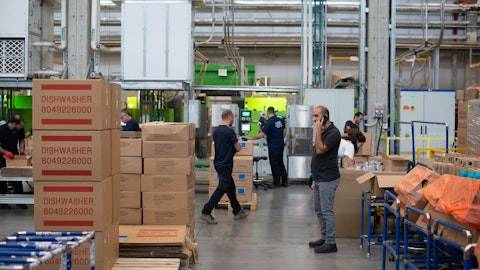TFI International Inc. (NYSE:TFII) Q3 2023 Earnings Call Transcript October 24, 2023
Operator: Good afternoon, ladies and gentlemen. Thank you for standing by. Welcome to TFI International’s Third Quarter 2023 Results Conference Call. At this time, all participants are in listen-only mode. Following the presentation, we will conduct a question-and-answer session. [Operator Instructions] Please be advised that this conference call will contain statements that are forward-looking in nature and subject to a number of risks and uncertainties that could cause actual results to differ materially. Also, I would like to remind everyone that this conference call is being recorded on Tuesday, October 24th, 2023. I will now turn the call over to Alain Bedard, Chairman, President and Chief Executive Officer of TFI International. Please go ahead, sir.

A fleet of long-haul cargo trucks on the highway transporting goods across long distances. Editorial photo for a financial news article. 8k. –ar 16:9
Alain Bedard: All right. Thank you, operator, and thank you, everyone, for joining us this morning. Yesterday, after market close, we’ve released our third quarter 2023 results. With weaker demand conditions persisting throughout the quarter, we’re proud of our solid execution which reflects continued adherence to our operating principles. As I mentioned before, our talented team understands the importance of profitability and cash flow, reacting quickly to market shifts and focusing even more intensely on the fundamentals when trade volume weakens. We view this underlying focus on profitability and cash flow as strategically important to the TFI International growth story, allowing us to consistently invest in the business, pursue M&A always in a disciplined manner and return excess capital to our shoulders whenever possible, which, as you know, is one of our guiding principle.
Taking a look at our third quarter results, we generated operating income of just over $200 million reflecting an operating margin of 12.3%. This compares to the prior year’s $318 million with a 17.1% margin. Adjusted net income of $136 million compares to $ 181 million the prior year and adjusted EPS of $1.57 was down from $2.01. Regarding net cash from operating activities, we generated $279 million during the second quarter. And in terms of free cash flow, which we view as strategically important, we produced nearly $200 million. Given the softer market condition, these solid results, along with strong returns on invested capital across all of our business segments, reflect well on the hardworking people of TFI and the importance we place on protecting margins, especially when the freight demand weakens.
It’s also important to point out that when comparing to the prior year, our results reflect not only our sales of CFI last August, but the associated $76 million gain on sales along with cost incurred to transition our IT system from UPS which will provide long-term efficiency advantages. In addition, we continue to face modestly unfavorable move in foreign exchange, I’ll emphasize the results are reporting are fully burdened, not adjusted for any of these items that affect the year-over-year comparison. All right. So let’s review how each of our business segment performed. P&C, which represents 7% of our segment revenue before fuel surcharge saw a 7% decline in revenue before fuel surcharge with the number of package also down 7%. Operating income of $25 million compares to $34 million the prior year with a margin of 23% relative to 28% previous year.
Our return on invested capital was down from 31% a year earlier and came in at still solid 27.6%. Overall, our P&C business is operating well given the weaker demand environment and with less contribution from fuel surcharge benefiting from our unique market exposure and ability to control cost. Moving onto LTL, which is 44% of segment revenue before fuel surcharge. Our revenue before fuel surcharge was down 12% on a 4% decline on shipments. Operating income of just over $100 million was virtually flat year-over-year. Within LTL, Canadian revenue before fuel surcharge increased 5% on a 5.3% in shipments. In addition, the quality and profitability of our business is apparent given difficult market condition with our operating ratio of solid 77.2% compared to 72.8% the prior year.
Similarly, our return on invested capital for Canadian LTL was 19.6% relative to 23.1% a year earlier. Within the US LTL, results clearly reflect our margin resilience, especially given an important 5% wage increase to our labor force during the quarter. Revenue per shipment before fuel surcharge remained flat year-over-year, while our number of shipments were down 7.5%. Our revenue before fuel surcharge of $581 million was down from $687 million a year earlier and we were able to keep our operating ratio flat at 90.8% year-over-year and improve it sequentially. Return on invested capital for US LTL was 15.2% compared to the prior year at 25.2%. Now let’s turn to truckload, which is 24% of segment revenue before fuel surcharge. Amidst a very weak market condition with lower demand and weaker rates, we believe that we were able to outperform the broader market benefiting from our specialized in Canadian exposure.
Our truckload revenue before fuel surcharge was down 21%, reflecting not only the weaker demand, but also the sale of CFI in August ’22, and to a lesser extent, unfavorable foreign exchange. Truckload operating income was $50 million relative to $97 million last year, and our operating ratio came in at 87.5% versus 81.1% a year earlier. So taking a closer look within truckload, although our specialized operation continued to benefit from self-help opportunities along with our diversity and exposure to better-performing niche markets, we were still impacted during the quarter by volume and pricing pressure. This is reflected in our new disclosure of weekly revenue per truck, which declined year-over-year. As a result of this as well as a slight FX and width, revenue before fuel surcharge declined 8% year-over-year to $325 million.
Our operating ratio was 87.8%, relative to 79.9%. And our return on invested capital was 10.1%, down from 12.7%. So taking a look at our Canadian-based conventional truckload business, we generated revenue before fuel surcharge of $79 million, almost entirely flat year-over-year and actually up on a consistent currency basis. However, our adjusted operating ratio was 87.8% relative to 75.5%, and our return on invested capital, which was 20.6%, a year earlier came in at 13.8%. This reflects a decline in both revenue per mile as well as number of miles partially offset by our ongoing focus on network, density and cost control. Wrapping up the business segment discussion, logistics represents 25% of segment revenue before fuel surcharge. Our solid results this quarter reflect our operational strength and ability to control costs.
We generated $416 million of revenue before fuel surcharge, which was down only 2% year-over-year, benefiting from our recent acquisition of JHT while also facing modest FX headwinds. However, on this relatively flat revenue, we were able to drive a greater than 40% increase in operating income to $41 million on a much stronger operating ratio of 9.8%, up a full 300 basis points. Our logistics return on invested capital was 15.5%, down from 21.1% the prior year. Overall, solid performance of our logistics segment benefited from better cost control, the strength of our same-day package delivery operation, the JHT acquisition, and our team’s ability to successfully navigate changing market conditions. Turning to our strong balance sheet and liquidity, which is always a focus at TFI International, we were able to further enhance our financial position both during and subsequent to the quarter.
First, we generated free cash flow of nearly $200 million, as I mentioned, and we ended September with a funded debt-to-EBITDA ratio of only 1.39. Second subsequent to the quarter, we were able to further strengthen our balance sheet with a private placement of $500 million, a fixed rate interest-only debt, bringing our overall weighted average interest rate to 4.5%, entirely fixed, with an overall weighted average duration of nine and a half year. As I mentioned many times, this financial strength is core to TFI International’s strategy, giving us the flexibility to make smart investments regardless of the cycle, while pursuing strategic M&A and returning excess capital to our shareholders whenever possible. Speaking of M&A, during the quarter, we completed four additional tuck-in acquisitions bringing our year-to-date total to eleven.
I’m also pleased to announce that our Board of Directors has raised the quarterly dividend by 14% and that the share repurchase program, our NCIB has been renewed for an additional year. I’ll now conclude with our updated full-year outlook before opening up to Q&A. Today, we are reaffirming our 2023 EPS guidance provided in July of a range of $6 to $6.50. We’re also maintaining our full-year free cash flow outlook at $700 million to $800 million, including CapEx of $200 million to $225 million. In addition, we have already exceeded a combined total of $500 million this year of capital deployed in M&A and share repurchase given our very strong financial position. And with that operator, if you could please open up the line so we can move to the Q&A portion of the call?
Operator: Thank you. [Operator Instructions] The first question comes from Ravi Shanker of Morgan Stanley. Please go ahead.
See also 19 Jobs AI Will Create and 30 Countries That Export The Most Weapons in the World.
Q&A Session
Follow Tfi International Inc. (NYSE:TFII)
Follow Tfi International Inc. (NYSE:TFII)
Ravi Shanker: Thanks. Good morning, Alain. Would love to get your thoughts on where you —
Alain Bedard: Good morning, Ravi.
Ravi Shanker: Think we are in the cycle right now. Obviously a very interesting time kind of bouncing on the bottom, but maybe some signs of life. When do you think that upcycle comes in? Is that late ’23, early ’24? How powerful is it going to be? Just your overall thoughts would be very helpful.
Alain Bedard: Yeah. You know Ravi, what we’re starting to see in Q4 is improvement, okay, versus our Q3 numbers in term of activity. But you know small, excuse me, small. We anticipate that ’24 is probably still going to be a transition year, okay. There’s a lot of things that are, you know, in terms of the politics, there’s an election in the US. There’s issues in Europe with war and things like that. So I think that, I mean, that’s what we’re doing now. We’re just going through our budget. And I think that I’m convinced that ’24 will be a better year than ’23 for us, okay, but it’s hard to have a good feel about how good is this going to be. Is that — are we going back to normal ’24 or it’s still going to be more towards kind of a transition to — towards better days, if you want to call it like that.
Ravi Shanker: Got it. That’s helpful. And for my follow-up kind of just given some of these structural changes in the LTL market in the US and some of the, I mean, just with the benefit of three months of hindsight and settling down kind of how do you think the whole post yellow situation has played out so far versus your expectations? What do you think happens in the near term and the medium term? Do you think it can kind of set you up pretty well for ’24?
Alain Bedard: You know, the fact that, you know, there’s been some major changes in our industry. And I think that the US LTL industry is very well disciplined, okay. So we went through some, you know, tough times in ’23. The fact that a significant player, okay, that was probably a very little margin player has gone from the market. I think this bodes well for the LTL industry. But notwithstanding that, Ravi, our focus at TFI with TForce Freight is really — it’s on costs. I mean, yes, you know, our market share could increase, our volume will increase slowly, but our major, major focus is we need to be leaner and meaner over there and that’s what we’re doing. So we’re providing the team over there with better information, financial information.
During the course of Q4 and into ’24, we will be providing what we have in Canada with all our LTL operation and package, financial information by terminal so that the manager could start doing a better job of managing costs. Because right now the excuse is, well, I don’t know. I don’t have the information, so I can’t do anything about it, right. So the excuse will be gone now, okay, the training and the education about all this financial information at the terminal level will be top priority for our EVP, Bob McGonigal; and Keith, the President of TForce Freight. So just to make a long story short about that. Our focus for us is really we have to be more efficient. We have to do better. We have to do more with less.
Ravi Shanker: Very helpful. Thanks a lot.
Alain Bedard: Pleasure.
Operator: The next question comes from Tom Wadewitz of UBS. Please go ahead.
Thomas Wadewitz: Yeah. Good morning, Alain. Wanted to see if you could talk a little bit more. Yeah, I wanted to see if you could talk a little bit more about kind of how yellow the business from yellow coming over affected performance in the quarter. I think we were anticipating maybe a sequential lift in price, but I don’t know if there’s like a significant mix effect within that. And then also just when you have kind of a disruptive step up in activity that can cause some inefficiency. So wanted to see if you could provide a bit more perspective on how that affected your results in 3Q?
Alain Bedard: Yeah. Yeah, very good question. So you know what Tom, what you could see is that if you look at our average weight per shipment. I mean, it’s up, I think, 7%, okay. So this is thanks to a little bit of change in our, you know, shipment, okay. So for sure, the fact that the display — has disappeared helped us improve our weight per shipment. In terms of pricing, our pricing and revenue per shipment ex-fuel is about flat year-over-year. So we were not really helped with that. Now, don’t forget, we used to run 23,000 shipments before what happened to YRC. We went all the way to 26,000, but now we’re back down to more like 24,500 to 25,000. And during the quarter, we had also — we went through increased cost in a sense because with pickup in volume, we had to, you know, bring back people, bring back people cost money.
And then whoops, again, okay, we went back closer to 24,500, 25,000 shipments. So then we have to readjust our labor force again. And as I said, you know, the problem we have at TForce Freight is when you don’t have financial information at the thermal level, the reaction time, okay, with all this variation of volume is too long, okay. And this is what we will be correcting in the future when we provide those guys with financial information — accurate financial information by the day, okay, by the week. So, all-in-all, if you look at our operating ratio, okay, we’re about flat year-over-year in Q3 for US LTL. One thing that we have to keep in mind is that our GFP operation, excuse me, was down on the revenue big time, okay. So but we’re coming back.
I mean our sales team is working on that. So that should improve for ’24.
Thomas Wadewitz: So I guess as a follow-up question, do you have any thoughts on how we should — what we should consider when we’re modeling 400 OR and also when we’re modeling 2024 US LTL OR?
Alain Bedard: You know what, Tom, excuse me. I think that ’24 LTL — US LTL OR should be less than 90. I’m just losing my voice, too bad. Yeah. So we should be in that neighborhood of 88 — 87, 88 to 90.
Thomas Wadewitz: Okay. Great.
Alain Bedard: Okay.
Thomas Wadewitz: Thanks for the time, Alain. Okay.
Alain Bedard: Pleasure, Tom.
Operator: The next question comes from Ken Hoexter of Bank of America. Please go ahead.
Ken Hoexter: Great. Good morning, Alain. Thanks for taking the questions.
Alain Bedard: Good morning.
Ken Hoexter: So just maybe to follow up on that for a second, lots of puts and takes in US LTL this quarter. There was the 5 million, I guess you’ve got the ongoing charge. Maybe you can talk a little bit about, you know, when you start transitioning from the UPS network, and then you start eliminating those contractual charges, the ground freight pricing. Is that something that continues to fade away? I just want to be able to step back and understand kind of how we should think about the US LTL and then your near-term target of moving sub-90 and your long-term target of getting to the, you know, as much as 80%.
Alain Bedard: Yeah.
Ken Hoexter: So maybe just thoughts about what’s in the number, what’s the clear, and then what’s the go forward?
Alain Bedard: Okay. So the transition from UPS at the latest, I mean, we’ve done, like, Q1 of 2024, okay. So what we’ve done so far is financial, so we moved Oracle to our own Oracle financial system. We did HR as well. We did HR in the summer. We also did the fleet in September. So we move from UPS fleet management to our own [indiscernible] system. So the only thing really of importance that’s left is the housing of our edge system. Excuse me. So that’s the only thing really left with those guys. So to me, all these transition costs, all these excess costs should be things of the past, probably into ’24. But for sure, you won’t see anything like that into after Q1 of 2024. Now, in terms of our GFP, so last year, we were just flying with that, doing really well.
This year, okay, starting Q1, I mean, our revenues started to drop. I mean, we had some — some customers’ issue, okay, that we have to fix which we have been fixing and working on. And now we’re starting to see revenue of GFP slowly picking up again. Our volume at GFP is down, like I said, big time, like 40% and this is not normal. So we had some issues with some, certain customers, but we’re working with them and we’re going to fix that. And it’s coming. Now in terms of the LTL, like I was saying to Tom, I’ve been seeing the plan. I’m going to be with the guys tomorrow, okay, and talking about their plan for ’24. But I can’t see us coming up with a plan with an OR of 90 plus. Okay. I think that the market is still going to be soft, okay, but we can’t blame the markets for that because us, we have a lot of work to do in our cost.



